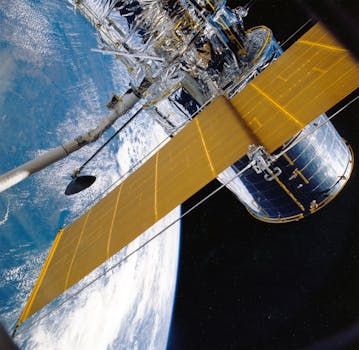
Beyond Earth: How Recent Advances Are Shaping Satellite Telecommunications
Satellite telecommunications is an essential aspect of modern communication, enabling global connectivity and facilitating the exchange of information across vast distances. Beyond Earth: How Recent Advances Are Shaping Satellite Telecommunications, the focus keyword, is a crucial aspect of this industry. Recent advances in space technology have significantly impacted the satellite telecommunications sector, driving innovation and growth. This article will delve into the recent developments and innovations in satellite telecommunications, exploring their implications and potential applications.
The advent of satellite telecommunications has transformed the way we communicate, allowing for seamless connectivity across the globe. With the increasing demand for global communication, the satellite telecommunications industry has experienced rapid growth, driven by advances in technology and infrastructure. One of the key drivers of this growth is the development of new satellite constellations, such as OneWeb and Starlink, which aim to provide high-speed, low-latency internet connectivity to underserved communities worldwide.
Advances in Satellite Technology
Recent advances in satellite technology have been instrumental in shaping the satellite telecommunications industry. The development of more efficient and powerful satellites has enabled the transmission of larger amounts of data, facilitating faster and more reliable communication. Additionally, the use of advanced materials and designs has improved the durability and lifespan of satellites, reducing maintenance costs and increasing overall efficiency. The integration of artificial intelligence and machine learning algorithms has also enhanced satellite operations, enabling real-time monitoring and optimization of satellite performance.
The introduction of new satellite bands, such as the Q/V band and the W band, has further expanded the capabilities of satellite telecommunications. These higher-frequency bands offer greater bandwidth and faster data transfer rates, supporting a wide range of applications, from high-definition video streaming to remote sensing and Earth observation. Furthermore, the development of advanced antenna technologies has improved the sensitivity and selectivity of satellite communications, reducing interference and increasing signal quality.
Impact on Global Connectivity
The recent advances in satellite telecommunications have had a profound impact on global connectivity, bridging the digital divide and enabling access to information and communication services for underserved communities. Satellite-based internet connectivity has become an essential tool for remote and rural areas, providing access to education, healthcare, and economic opportunities. The use of satellite telecommunications has also facilitated emergency response and disaster relief efforts, enabling rapid communication and coordination in times of crisis.
The growth of satellite telecommunications has also driven innovation in various industries, from aviation and maritime to agriculture and environmental monitoring. The use of satellite-based navigation and communication systems has improved safety and efficiency in transportation, while satellite-based Earth observation has enabled more accurate monitoring of climate change, deforestation, and natural resource management. Moreover, the integration of satellite telecommunications with other technologies, such as the Internet of Things (IoT) and cloud computing, has created new opportunities for data-driven decision-making and smart infrastructure development.
Challenges and Future Directions
Despite the significant advances in satellite telecommunications, there are still challenges to be addressed, from regulatory frameworks to technical limitations. The increasing number of satellites in orbit has raised concerns about space debris and the need for more efficient and sustainable satellite operations. Additionally, the development of new satellite constellations has sparked debates about spectrum allocation, interference, and the potential impact on astronomical research.
As the satellite telecommunications industry continues to evolve, it is essential to address these challenges and ensure that the benefits of satellite-based communication are equitably distributed. The development of more advanced satellite technologies, such as quantum satellites and optical communication systems, will further expand the capabilities of satellite telecommunications, enabling faster and more secure data transfer. Moreover, the integration of satellite telecommunications with emerging technologies, such as 5G and 6G networks, will create new opportunities for immersive and interactive communication, from virtual and augmented reality to holographic projections and beyond.




